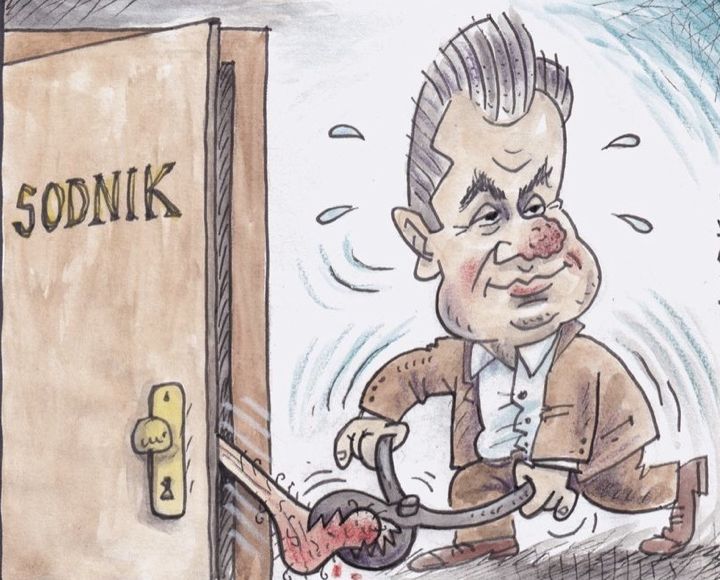What do we see?
The cartoon shows the current Slovenian Minister of the Environment Andrej Vizjak squeezing the testicles of a judge (“sodnik” is the word for ‘judge’ in Slovenian). The cartoon is by Marko Kočevar and first published in the Slovenian daily Delo, on 5 November 2021. (https://www.delo.si/karikatura/pogosta-praksa/). The cartoon was accompanied by a quote from an old conversation between Vizjak and businessman Bojan Petan:
“Very well, we will shoot at sparrows with all guns blazing. If we revoke the injunctions, we will squeeze the balls off one of the judges, you know that. It will be quick,”
[»Daj, no, mi bomo šli z vsemi kanoni na to. Razveljavili začasne odredbe, veš, da bomo kateremu od sodnikov jajca strli. To se bo hitro zgodilo,« je pred 14 leti v pogovoru s poslovnežem Bojanom Petanom dejal minister Andrej Vizjak.]
The cartoon went viral on Viber, Instagram and TikTok.
What public issue is addressed here?
The cartoon was created in response to recently leaked 14-year-old recordings (from the year 2007) of the discussion between then Minister for the Economy Andrej Vizjak and businessman Bojan Petan. Minister Vizjak encouraged Petan to do big business evading tax, promising that he would “squeeze the judge’s testicles” to get approval for whatever he is told to do.
Economic crime and tax evasion are major issues in Slovenian politics. On the one hand, the cartoon shows the pressure that right-wing politics exert on the legal system, and on the other hand, it ridicules politicians’ self-absorbed and self-confident feeling of being omnipotent. Nevertheless, the cartoon implies that Vizjak is acting surreptitiously: the man in the cartoon is sweating with nervousness and at the same time anxiously looking around to make sure that no one sees him in action.
What does the humour do?
Although the cartoon is authorised, we can understand it also as a folkloristic response to the news that circled on the social media very quickly without the name of the author, but as the strong opinion of its distributors. It fully intertwines with the concept of newslore (Frank 2011) to describe “folklore [jokes, urban legends, digitally altered photographs etc.] that comments on, and is therefore indecipherable without knowledge of, current events” (Frank 2011: 7). We also have to emphasize that modern media have expanded ordinary citizens’ access to satirical commentary on everyday news and events; it reflects the universal desire to unmask hypocrisy, to criticise duplicity, corruption and failure, and to ridicule the self-important (Davis 2017). The cartoon caricature literally transposes the politician’s words into a picture and adds the contextual fact that judge is hiding behind the closed door and is nervous in the face of the fraud that is about to be approved at the highest level of government. The caricature humiliates and mocks Minister Vizjak, while the hidden judge functions as the epitome of Slovenian justice system, which is hiding behind the doors from the illegal political pressure as well as from society’s disclosure of the cooperation of legal system and politics. The caricature shows the limits of local humour, humour that requires knowledge of the political background and the event being criticised to be understood.
Bibliography:
Davis Milner, Jessica. 2017. Satire and Politics. The Interplay of Heritage and Practice. London: Palgrave Macmillan.
Frank, Russell 2011. Newslore: Contemporary Folklore on the Internet. Jackson: University Press of Mississippi.
